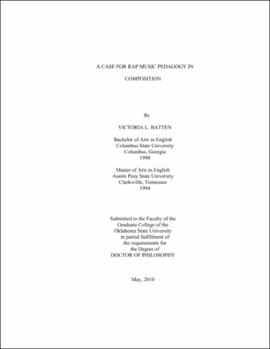| dc.contributor.advisor | Batteiger, Richard P. | |
| dc.contributor.author | Batten, Victoria L. | |
| dc.date.accessioned | 2013-11-26T08:29:29Z | |
| dc.date.available | 2013-11-26T08:29:29Z | |
| dc.date.issued | 2010-05 | |
| dc.identifier.uri | https://hdl.handle.net/11244/7053 | |
| dc.description.abstract | Scope and Method of Study: This dissertation explored the feasibility of a rap music pedagogy for "all" students. After reviewing the literature and critical scholarship, I emerged skeptical about the claims made by some advocates. Grounded in a Literacy narrative about a language situation in Hawaii quite ignored in contemporary research and scholarship and about my acquisition of Standard American English (SAE), this dissertation incorporated the exploratory case study, which used a fifteen-item questionnaire to probe participants' knowledge of expected literary categories elicited through semi-structured interviews. Social categories were emergent. In the case study, evidence constituted the knowledge of student participants (S1, S2, S3, and S4); a music pedagogy lesson plan (F1); the available research literature and critical scholarship, and PI's experiences with using rap music in the basic-writing classroom and with analyzing and interpreting rap music texts. | |
| dc.description.abstract | Findings and Conclusions: Findings confirmed the feasibility of a rap music pedagogy but not for "all" students. Even though there was a diverse make up of participants in this case study, PI found that varying language use and interests in music must be considered when implementing a rap music pedagogy. While I emerged skeptical about the claims made by some advocates for the use of only rap music in composition, the data found that the social approach was rooted in participants' experiences and was universal and that students would benefit from a pedagogy that implemented all three approaches. This case study found two alternatives for implementing the use of rap music in the composition classroom. The first was to allow students to choose their own rap music texts to analyze, interpret, and write about (Daspit, 1999). The second was to use a music pedagogy which facilitated music and language diversity by allowing students to choose songs from a variety of music genres: rap, country and western, red dirt, jazz, rock, rhythms and blues (F1). | |
| dc.format | application/pdf | |
| dc.language | en_US | |
| dc.rights | Copyright is held by the author who has granted the Oklahoma State University Library the non-exclusive right to share this material in its institutional repository. Contact Digital Library Services at lib-dls@okstate.edu or 405-744-9161 for the permission policy on the use, reproduction or distribution of this material. | |
| dc.title | Case for rap music pedagogy in composition | |
| dc.contributor.committeeMember | Halleck, Gene B. | |
| dc.contributor.committeeMember | Brooks, Ronald Clark | |
| dc.contributor.committeeMember | Duhon, Gary J. | |
| osu.filename | Batten_okstate_0664D_10772 | |
| osu.accesstype | Open Access | |
| dc.type.genre | Dissertation | |
| dc.type.material | Text | |
| dc.subject.keywords | african american vernacular english (aave) | |
| dc.subject.keywords | derived system | |
| dc.subject.keywords | hawaii creole english (hce) | |
| dc.subject.keywords | literacy narrative | |
| dc.subject.keywords | peda | |
| thesis.degree.discipline | English | |
| thesis.degree.grantor | Oklahoma State University | |
